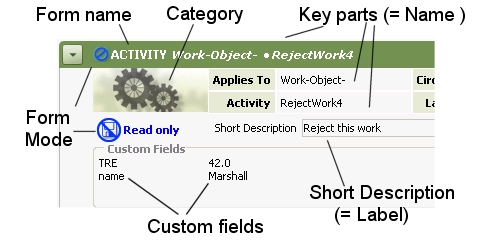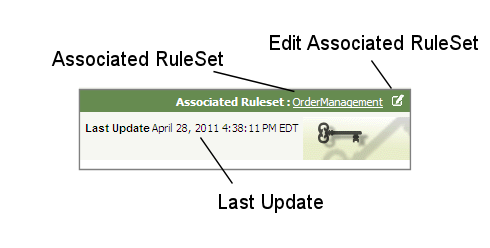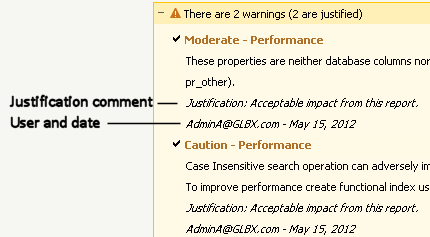|
The sections of rule and data forms contain important information, controls, and visual cues.
 Understanding the top left area
Understanding the top left area
The top left portion of each rule form includes the form name, a mode icon, and the key parts of the specific rule. Click the expand button (![]() ) to expand the header area. Click the collapse button (
) to expand the header area. Click the collapse button (![]() ) to hide the header area.
) to hide the header area.

| Form Name |
Displayed in the upper-left corner, the form name provides an easier-to-say name associated with the rule type or data class. See Rules by form name and Data classes by form name for the complete lists. Form names are similar to common names in most cases. |
||||
| Category Image |
The category image suggests how this rule type (or data class) is used. |
||||
| Form Mode |
Indicates whether this form contains a locked (read-only) instance, or errors, or other modes. A smaller version of the icon is always visible in the top bar. Two common examples:
See How to complete rule form and data form fields for an explanation of form modes. |
||||
| (varies) |
Your Application Explorer settings govern what appears in the rule headers. To review or change these settings, access the Application Explorer and choose |
||||
| Names (Key Parts) |
The expanded header area lists all key parts, with field labels. You cannot alter the value of rule key parts directly on the form. You determine key parts in the New form or the Save As form. See Completing the new rule dialog and How to enter rule keys using Save As. |
||||
| Description |
The Description text aids other developers in identifying the purpose and source of this instance. (This field is called Short Description on some rule forms.)
|
||||
| Custom Fields |
If custom fields (of type
Along with key parts, RuleSets versions, and circumstances, custom fields help to label or classify rules. For more about the uses and development of custom fields, see How to classify and select rules based on Custom Field values. The HTML rule Embed-CustomFields.defaultFields sets the appearance of this area. You can save a copy of this rule into your application and modify it to present custom fields in a way that best suits the needs of your application and your user community. For more information, see the Pega Development Network article |
 Understanding the top right area
Understanding the top right area
For rules, the RuleSet, version, and Availability icon appear at the top right of the form.

For data instances, the associated RuleSet and the Edit the Associated RuleSet icon appear at the top right of the form. If there is no associated RuleSet specified, the Associated RuleSet field displays [none].

In both rule and data instance forms, click the plus sign in the top left area of the rule form to see other qualifications and information.
| RuleSet and Version |
For rules, identifies the RuleSet and version that apply to this rule. Rules in RuleSet names beginning with the five characters |
| Availability |
For rules, an icon indicates whether this rule is available, blocked, withdrawn, or final. See available rule. Click the Availability toolbar button ( A green clock icon indicates that this rule is time-qualified. |
| Locked? |
For rules, a green lock icon ( |
| Associated RuleSet |
For data instances, identifies the associated RuleSet for this data instance. To assist in application packaging and migration, you can "tag" data instances with a RuleSet. Such associations make it easier to identify which data instances to include in an application package. Associating a RuleSet with a data instance does not affect or restrict any runtime behavior. See Associated RuleSet. |
|
|
For data instances, click to update the Associated RuleSet to another RuleSet. When you click |
| Checked Out From |
When you later complete checking in this rule (using either the Check-in button |
| Checked Out By |
This field does not indicate if a developer has performed a private check out on the rule. |
| Circumstance or Base |
If this rule is circumstance qualified, the property name and value appear here, with a circumstance icon ( If this rule is a base rule for other rules (that are qualified by circumstance or time-qualified), the base rule icon ( |
| Last Update |
Identifies the date and time this instance was last saved. |
 Understanding the errors-and-warnings section
Understanding the errors-and-warnings section
When you save a rule or data form and the system detects one or more error or warning conditions, the following section appears:

Expand the section to view the messages and take corrective action based on the situation.

|
|
Error conditions identify situations that prevent the system from saving the rule or data form. You must address the situation before the system will save the form. |
|
|
Warning conditions identify unexpected and possible unintended situations, practices not recommended, or variances from best practices and guardrails. They do not prevent the rule from saving. (See warning.) The warning conditions are listed in the rule form in order of severity (Severe, Moderate, Caution) so that the most severe ones are displayed first. If there are justified warning conditions, the errors-and-warning section displays how many are justified. 
When you expand the section to view the warning messages, the justification comment entered by the user who justified the warning is displayed after the warning. The user who justified the warning and the date when the comment was entered is also displayed. 
See warning for details about justifying warnings. |
![]() Click any tab to bring it to the front. (Some users can access only the left tab of certain rule forms.)
Click any tab to bring it to the front. (Some users can access only the left tab of certain rule forms.)
History tab
Every form has History tab. It can contain a text description of the rule or data instance, and show who created and updated it and when. In some cases, you can roll back a rule to an earlier version. Here you can also specify custom fields for the current rule. See:
- How to complete the History tab of a data form
- How to complete the History tab of a rule form
- How to recover (undelete) a deleted rule
- How to restore an earlier copy of a rule after check-in
Pages and Classes tab
Many rule forms contain a Pages & Classes tab. See How to complete a Pages & Classes tab.
Other tabs
Other tabs vary by form. Consult the help topics for information on specific tabs and fields.

|
check out, rule resolution, sibling, time-qualified rule |

|
Using the toolbar
Visual dictionary About RuleSet rules |

 Identifying parts of rule and data forms
Identifying parts of rule and data forms
 When a displayed rule is checked out (usually by yourself, either with a standard check out or private check out), this field shows the original RuleSet and version. Click the link to open the current checked-in version.
When a displayed rule is checked out (usually by yourself, either with a standard check out or private check out), this field shows the original RuleSet and version. Click the link to open the current checked-in version. ) the revised rule instance returns to this RuleSet and version, replacing the earlier copy. See
) the revised rule instance returns to this RuleSet and version, replacing the earlier copy. See  Designer Studio basics
Designer Studio basics